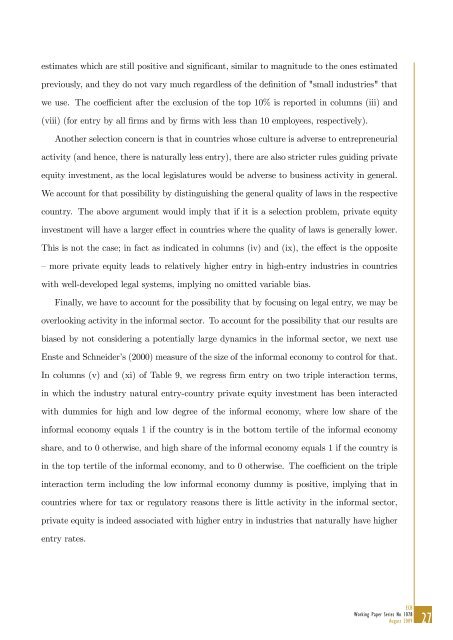On the real effects of private equity investment: evidence from new ...
On the real effects of private equity investment: evidence from new ...
On the real effects of private equity investment: evidence from new ...
- No tags were found...
Create successful ePaper yourself
Turn your PDF publications into a flip-book with our unique Google optimized e-Paper software.
estimates which are still positive and signi…cant, similar to magnitude to <strong>the</strong> ones estimatedpreviously, and <strong>the</strong>y do not vary much regardless <strong>of</strong> <strong>the</strong> de…nition <strong>of</strong> "small industries" thatwe use. The coe¢ cient after <strong>the</strong> exclusion <strong>of</strong> <strong>the</strong> top 10% is reported in columns (iii) and(viii) (for entry by all …rms and by …rms with less than 10 employees, respectively).Ano<strong>the</strong>r selection concern is that in countries whose culture is adverse to entrepreneurialactivity (and hence, <strong>the</strong>re is naturally less entry), <strong>the</strong>re are also stricter rules guiding <strong>private</strong><strong>equity</strong> <strong>investment</strong>, as <strong>the</strong> local legislatures would be adverse to business activity in general.We account for that possibility by distinguishing <strong>the</strong> general quality <strong>of</strong> laws in <strong>the</strong> respectivecountry. The above argument would imply that if it is a selection problem, <strong>private</strong> <strong>equity</strong><strong>investment</strong> will have a larger e¤ect in countries where <strong>the</strong> quality <strong>of</strong> laws is generally lower.This is not <strong>the</strong> case; in fact as indicated in columns (iv) and (ix), <strong>the</strong> e¤ect is <strong>the</strong> opposite– more <strong>private</strong> <strong>equity</strong> leads to relatively higher entry in high-entry industries in countrieswith well-developed legal systems, implying no omitted variable bias.Finally, we have to account for <strong>the</strong> possibility that by focusing on legal entry, we may beoverlooking activity in <strong>the</strong> informal sector. To account for <strong>the</strong> possibility that our results arebiased by not considering a potentially large dynamics in <strong>the</strong> informal sector, we next useEnste and Schneider’s (2000) measure <strong>of</strong> <strong>the</strong> size <strong>of</strong> <strong>the</strong> informal economy to control for that.In columns (v) and (xi) <strong>of</strong> Table 9, we regress …rm entry on two triple interaction terms,in which <strong>the</strong> industry natural entry-country <strong>private</strong> <strong>equity</strong> <strong>investment</strong> has been interactedwith dummies for high and low degree <strong>of</strong> <strong>the</strong> informal economy, where low share <strong>of</strong> <strong>the</strong>informal economy equals 1 if <strong>the</strong> country is in <strong>the</strong> bottom tertile <strong>of</strong> <strong>the</strong> informal economyshare, and to 0 o<strong>the</strong>rwise, and high share <strong>of</strong> <strong>the</strong> informal economy equals 1 if <strong>the</strong> country isin <strong>the</strong> top tertile <strong>of</strong> <strong>the</strong> informal economy, and to 0 o<strong>the</strong>rwise. The coe¢ cient on <strong>the</strong> tripleinteraction term including <strong>the</strong> low informal economy dummy is positive, implying that incountries where for tax or regulatory reasons <strong>the</strong>re is little activity in <strong>the</strong> informal sector,<strong>private</strong> <strong>equity</strong> is indeed associated with higher entry in industries that naturally have higherentry rates.ECBWorking Paper Series No 1078August 200927















